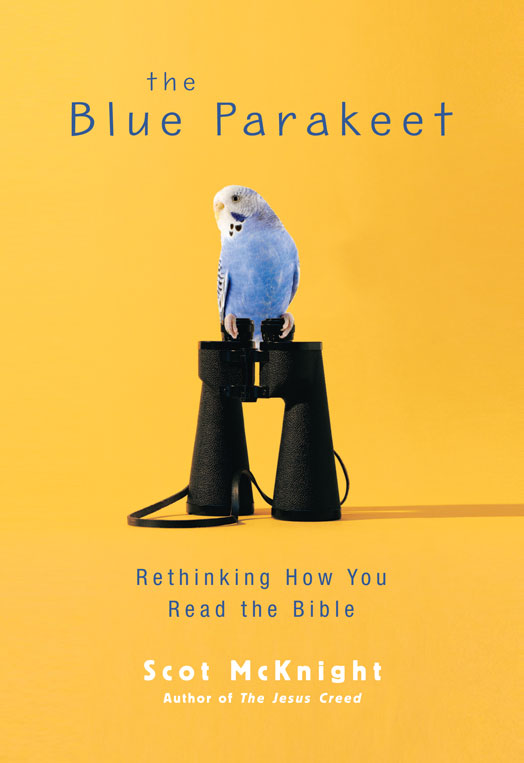
Synopsis
Overall Rating
Final Thoughts
Year Published
2008
Authors
Topics
Synopsis
Final Thoughts
Overall Rating
I talked (partially) about a Scot McKnight book previously in my American Christians Have Failed article. I come now to talk a book he writes about how to read the Bible. Let’s be honest. We all read the Bible in a certain way. Most of the time we read it to get what we want out of it. McKnight challenges us to look at the Bible in a different way and, therefore, read it in a new way. This new reading shines in what he calls “blue parakeet” passages- those passages we often choose to silence or ignore. When read the Bible not silencing them, but investigating what they (and the Bible has a whole means) we have a more accurate version of God’s message for us and how we are to live.
I’m not sure where along my journey, but somehow I began to read the Bible the exact way this book is presenting. I sat down to read the book saying, “Okay, I’ve read some of McKnight’s stuff before. He’s pretty good. Let’s see what he has to say.” Constantly whilst reading I found myself saying, “Yes!” to the points he was making. He presents the Bible, and how to read it, in a way that many US Bible Believers refuse to do.
Before we begin to discuss how McKnight says we should read the Bible, let’s take a moment to address the ways people do read the Bible. When we read the Bible we can recognize that it is an ancient text and make and attempt to “retrieve” what the text is saying. With this method, we tend to either try to apply everything today or try to apply very little to today. This causes problems because it’s obvious that we can’t apply all the teachings of the Bible today (how many of you won’t even shake a women’s hand during the period around her menstruation? Anyone?). On the flip side, we also need to be weary of not applying enough of the Bible’s teachings today.
The most common reading technique is to read the Bible through our tradition. This is to say we go to the Bible and say, “Here’s what we say we believe. How do we back that up.” With this method, we sometimes put our own views into the Bible. It also presents us from having a renewed and reworked understanding of the Bible throughout times. We become rigid in our teachings and, ultimately, legalistic. We refuse to let the Bible speak for itself and, rather, choose to choose what the Bible says based on what our tradition finds most important. (There are others he presents, but these are the biggest I would say.)
Within these, we have what McKnight calls shortcuts to reading the Bible. We either read it as a list of blessings and promises, as a puzzle that needs to be pieced together or through the eyes of a maestro. When we read it as blessings and promises we ignore the parts of the Bible that may not be blessings or promises. We have a very limited view of the Bible in this way, and it hinders not only our understanding of the Bible but our understanding of God. If we approach the Bible as a puzzle, we tend to throw out or ignore the pieces that don’t fit. We’re also, ultimately, unable to find all the pieces we need, so we end up with an incomplete final “picture”. This method is also problematic because we don’t have a consensus on what the final “picture” is so we decide it on our own, and everyone’s completed Bible puzzle turns into what they want it to be.
Reading the Bible through the eyes of a maestro is the most reasonable of the shortcuts, but it too has its shortcomings. When we read it through the eyes of a maestro, we often forget about everyone else. We approach the Bible and say, “this is what so and so says” (be it Jesus, James, Peter, Paul, Pastor Smith, etc.) and try to fit everything into that framework. We ignore what others say about certain things because we are so concerned with what our Maestro says. Which leads us to an important point McKnight emphasizes that many of us overlook-
the Bible has an abundance of authors, and there’s a reason for that.
In order for us to grasp the importance of this distinction, we need to return to the fundamental nature of the Bible. The Bible is, first and foremost, a story. The story is (simply) summarized as: creation, fall, redemption. McKnight wants to break that down further, though. When we were created we were created to be in oneness; during the fall there became otherness. There are now thousands of years between this time and redemption that the simplistic telling of the story seems to leave out. It’s God’s plan to bring oneness back, and he lets humanity try to do it for a few thousand years in the Old Testament. It doesn’t work, though, and humanity seems to be continuing further and further into otherness. That’s when Christ comes and fixes what’s broken. He redeems us and brings us back into oneness- both with each other and with God.
When we remember this, it brings new life to the Bible. What we see in each Biblical author’s writing is their version of the Story. Their “wiki-story” as McKnight calls it. They’re not changing the story, they’re just telling it in their own way. Another important point is brought into focus now- God always has, and always will, speak to people in their day in their way. The wiki-stories of the Bible allow for this. God spoke to Moses in Moses’ way based on his culture and history; He then spoke to Paul in a new way in a new day that best resonated with Paul and his contemporaries.
Moses, Paul, and the others, then took this and used it to shape their tellings of the Story, their wiki-stories. Our common saying for things we don’t apply from the Bible is, “that was then, this is now.” How true that is. But how ignorant we are to believe it only applies to certain things. Everything written in the Bible was then, and now we have now. That’s not to say what’s written doesn’t have value today. Far from it.
But it is to say that, in order to understand the Bible (and properly live out what it teaches) we need to figure out what exactly it said in their times. We do this by addressing the historical and cultural context that the writings are placed. We cannot simply read the text without doing so and expect to understand what the writers were actually saying because it wasn’t written for us. Take a sermon for an example. Many make references to cultural practices or phenomenon without explaining them. Hearing them without knowing these things would leave us confused. That’s what we have when we read the Bible without taking context into question. That’s what McKnight presents within the Book. That’s the type of reading I do when I present things here on scarytino. And McKnight, myself, and many others believe this is the way God intended for us to read the Bible. And it makes sense.
Not only that, but it allows us to see how the passage or topic fits into the Story as a whole. We can see whether our reading of the passage aligns with God’s word throughout the Bible. If it does, we may be reading it appropriately in our way for our day. If not, perhaps we need to take a new look at what it was saying in that day in their way in order to appropriately apply it in our way in our day.
If we continue to study the Bible this way we find that many passages are not what we once thought they were- “turn the other cheek” isn’t about just taking what comes your way, Paul doesn’t actually prohibit women from being a part of Church leadership, homosexuals are not unashamedly hated by God. We must, though, remember to read everything in the Bible as a wiki-story of the main story-oneness, otherness, and renewed oneness (again, both with each other and with God)- presented in a specific way for people of a specific day. In doing so we will have a greater appreciation for God’s word, as well as those who wrote it down for us.




